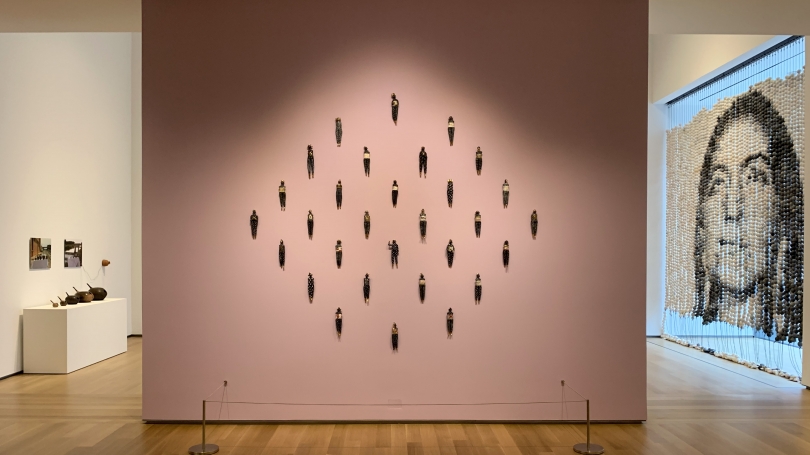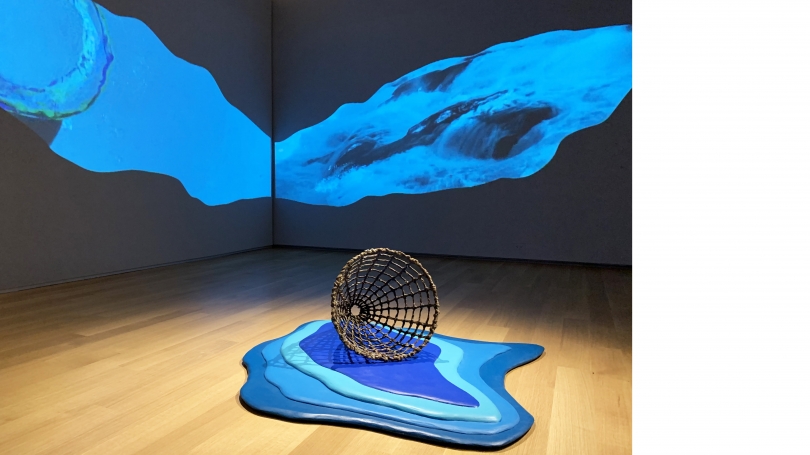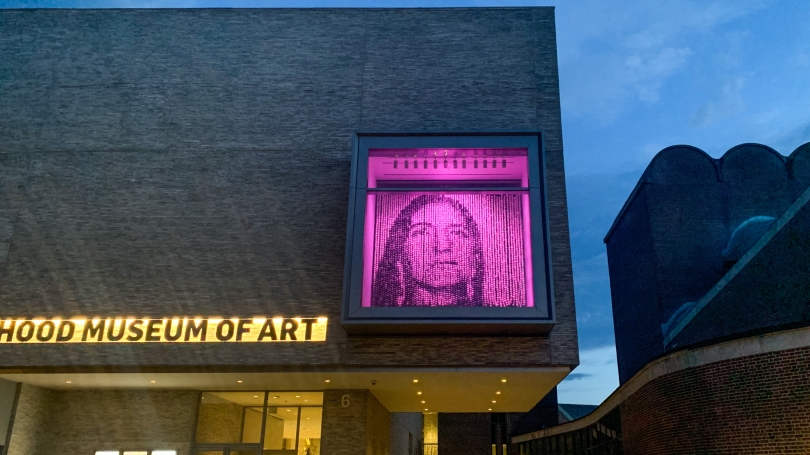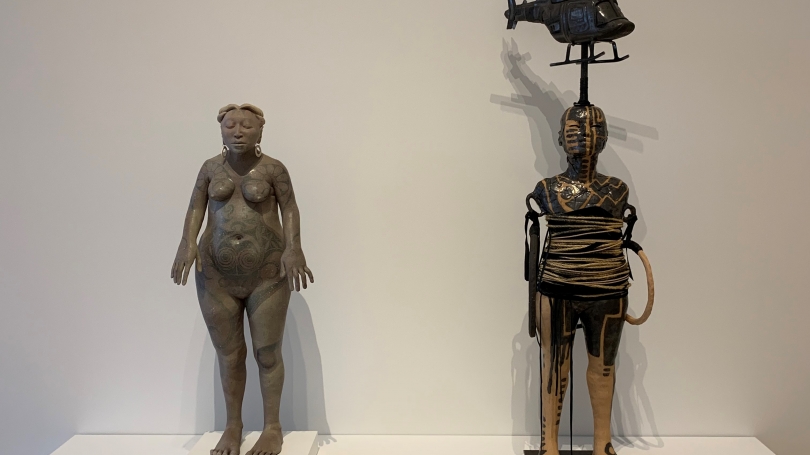As Women's History Month comes to a close, the Hood Museum of Art joins the National Museum of Women in the Arts in celebrating the dynamic, innovative, and groundbreaking work of women in the arts. The #5WomenArtists featured in our most recent exhibition, Form and Relation: Contemporary Native Ceramics, each have unique practices that give attention to what is required to sustain healthy human and non-human relationships.
Using the land as a central organizing medium, Form and Relation draws not only on the materiality of the clay but also on the knowledge embedded within it. In this particular moment of global urgency – consumed by a pandemic and the politics surrounding it – their intellectual work is a crucial contribution to conceptions of interconnectedness reflected in the arts. Native women artists have shaped the visual culture of hundreds of Indigenous nations for generations but have only recently received recognition for this from the art world at large, notably to the credit of the growing number of Native women curators and scholars in the field.
Seen together in this exhibition, Anita Fields, Courtney M. Leonard, Rose B. Simpson, Kali Spitzer, and Roxanne Swentzell speak to a myriad of social concerns that are at the forefront of present societal conversations.
Osage / Mvskoke (Muscogee Creek) artist ANITA FIELDS was born in Hominy, Oklahoma, in 1951. From a young age, Fields expressed an intuitive inclination toward art making. She works mostly in black and white, using a range of techniques to create layered, textural works that give the illusion of an expanded color palette. Fields cites the influence of Osage epistemologies, particularly the life-sustaining concept of duality, as integral to her work. She specializes in ceramic figures, landscapes, and fiber-based forms. Form and Relation features these staples of her practice, including the ceramic landscape When Referencing the Earth and Sky (2019) and an installation of 30 of her ceramic figures, So Many Ways to Be Human (2019).
COURTNEY M. LEONARD is a Shinnecock artist, born in 1980 and raised on her Shinnecock Nation homelands, located on what is now referred to as Long Island. Leonard is a part of the Offshore Art movement, a trend concerned with global climate change and its effects on the conditions of the oceans and their shorelines. Leonard's most recent and ongoing series, BREACH, engages Indigenous coastal communities across the world and interrogates how culture sustains itself when its defining lifeforce is threatened. Leonard spent two years researching for her site-specific installation at the Hood Museum, BREACH: Logbook 20 | NEBULOUS, which is concerned with the flow of the Connecticut River into the Atlantic and the facilities that impede this route, such as the Wilder Dam. NEBULOUS underscores the necessity to acknowledge Indigenous knowledge-based systems in the face of corporate or state-controlled resource extraction.
ROSE B. SIMPSON (b. 1983) is a multimedia Kha'p'o Owingeh (Santa Clara Pueblo) artist who often incorporates metal and found materials into her figural sculptures. Much of Simpson's work responds to the trauma of the postcolonial era and its effects on personal, cultural, and emotional identity. Simpson is interested in the power and possibility of art making to be transformative and used as a tool for encouraging empathy. Her sculptures are often armored, not with weapons but instead with protective gear that transform them into warriors. Dream Machine (2016) stands resolutely, crowned with a steel and ceramic helicopter decorated in the style of black-on-black pottery, a tribute to the knowledge and creativity to those who came before.
Kaska Dena and Jewish Romanian artist KALI SPITZER (b. 1987) is from Daylu, British Columbia. Spitzer specializes in film and wet-plate collodion photography, with a commitment to documenting cultural practices within her own community, such as hunting, fishing, trapping, and tanning. Spitzer is also committed to capturing intimate portraits of Indigenous women, and queer, trans, and non-binary people—images that resist colonial voyeurism and fetishization. Spitzer's Incantation (2018), an audio work that featured the voice of one of her sitters, accompanies Cannupa Hanska Luger's Every One (#MMIWQT Bead Project) (2018). Together, the two advocate for wider recognition the current crisis of missing and murdered Indigenous women and LGBTQIA+ people, which includes a call for adequate data collection of this violence in the United States.
Kha'p'o Owingeh (Santa Clara Pueblo) ceramicist ROXANNE SWENTZELL was born in 1962 in Taos, New Mexico. A renowned ceramicist, Swentzell is known for her striking figural sculptures, which touch on her own experiences as well as broader human emotion. Drawing from the context of the gender and societal structures of Santa Clara, Swentzell focuses much of her attention on representations of womanhood. Commitment to rendering honest and vulnerable depictions of the human form has made her a trailblazer in the realm of Native ceramics. Swentzell and Rose B. Simpson – her daughter – were commissioned to create a collaborative work for the exhibition, Timeline Necklace (2019), which is a semi-autobiographical visualization of the pair's relationships to clay, family, and life cycles. Swentzell's sculpture Sitting on My Mother's Back (2014) touches on similar themes of human responsibility to care for the Earth and reciprocate what it provides for us. Roxanne Swentzell has championed the practice of permaculture for most of her life, living by principles that ensure healthy ecosystems for generations to come.
At times, these artists' works come into harmonious conversation with one another. We invite you to explore their practices and consider the possibilities when embracing multiple ways of knowing.
Written by Morgan E. Freeman, Co-Curator of "Form & Relation: Contemporary Native Ceramics" and Native American Art Fellow at the Hood Museum
About the author: Morgan E. Freeman joined the Hood in September 2018. She provides support for the Hood's Native American art collection through archival research, exhibition development, and collections-based teaching. Morgan is a recent graduate of Tufts University, where she earned a bachelor's degree in American studies. Prior to starting at the Hood, she held internship positions at the Studio Museum in Harlem and the Museum of Fine Arts, Boston. She is a member of the Nipmuc Nation.



